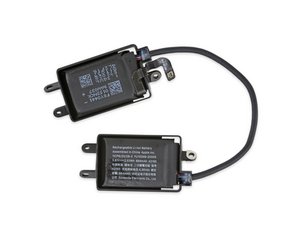crwdns2933803:09crwdne2933803:0
crwdns2933797:0Jeff Suovanencrwdnd2933797:0crwdne2933797:0
crwdns2936043:0crwdne2936043:0 crwdns2933505:0crwdne2933505:0 Jeff Suovanen
- crwdns2933769:0crwdne2933769:0
- crwdns2933771:0crwdne2933771:0
- crwdns2933801:0crwdne2933801:0
crwdns2933807:0crwdne2933807:0
| + | [* black] With the screws removed, the drivers flip right out, revealing a pair of repair-friendly spring contacts directly underneath. Neat! |
|---|---|
| + | [* black] That provides enough clearance to remove our next target: the battery. As shown in the X-ray, both battery cells live in the right ear cup, tethered together by a single cable. |
| + | [* black] To our relief, both cells are fastened with screws, not adhesive. Even better, they provide power via a single, iPhone-style pop connector—no solder here. |
| + | [* black] That was surprisingly painless, particularly for an [https://www.ifixit.com/News/8690/airpods-are-disposable|AirPods] product. Were it not for the glue-y opening procedure, you could almost say it was ''easy''. Imagine that—easily replacing a consumable component, instead of throwing the whole device away. |
| + | [* black] Made by Sunwoda, the two cells are wired in parallel, with a total capacity of 664 mAh and 2.53 Wh total energy at 4.35 V. Each cell measures approximately 5.7 x 20 x 28 mm. |
| + | [* black] This is right in line with the 2.39 Wh cell in the Bose NC 700 wireless headphones, which also promise around 20 hours of listening time. Sony WH-1000XM4s offer a longer, 30 hour listening time, with a correspondingly larger 4.1 Wh battery driving them. |
crwdns2933777:01crwdne2933777:0
crwdns2933779:0crwdne2933779:0

crwdns2915182:0crwdne2915182:0
crwdns2933777:02crwdne2933777:0
crwdns2933779:0crwdne2933779:0

crwdns2915182:0crwdne2915182:0
crwdns2933777:03crwdne2933777:0
crwdns2933779:0crwdne2933779:0

crwdns2915182:0crwdne2915182:0